10 Of The Most Fascinating South African Animals To Encounter
Here’s a tip you can’t find in any guidebook.
When you visit South Africa, you don’t necessarily need to go on a safari in Kruger Park to encounter the South African wildlife.
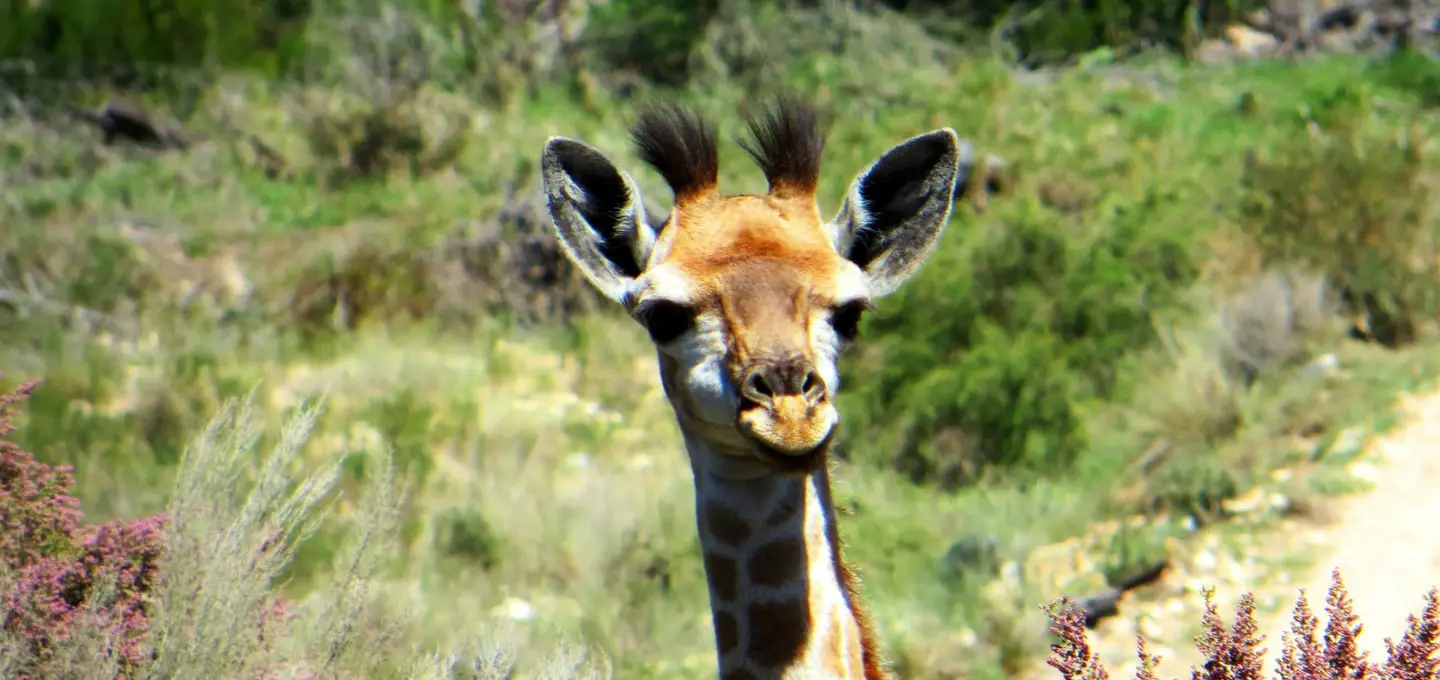
There are game reserves scattered all over the country.
And if you’re not explicitly looking to see the African animals in their natural environment, a great alternative to a reserve is a sanctuary. You can learn a lot about the animals’ habits, the dangers they face, and the process of saving and ensuring a better life for them.
In an animal sanctuary, you can get extremely close to the wild animals without the fear of being attacked.
Of course, there is also a lot of fascinating South African wildlife you can meet at the beach or at the side of the road.
So let’s find out where you can encounter the most fascinating South African animals.
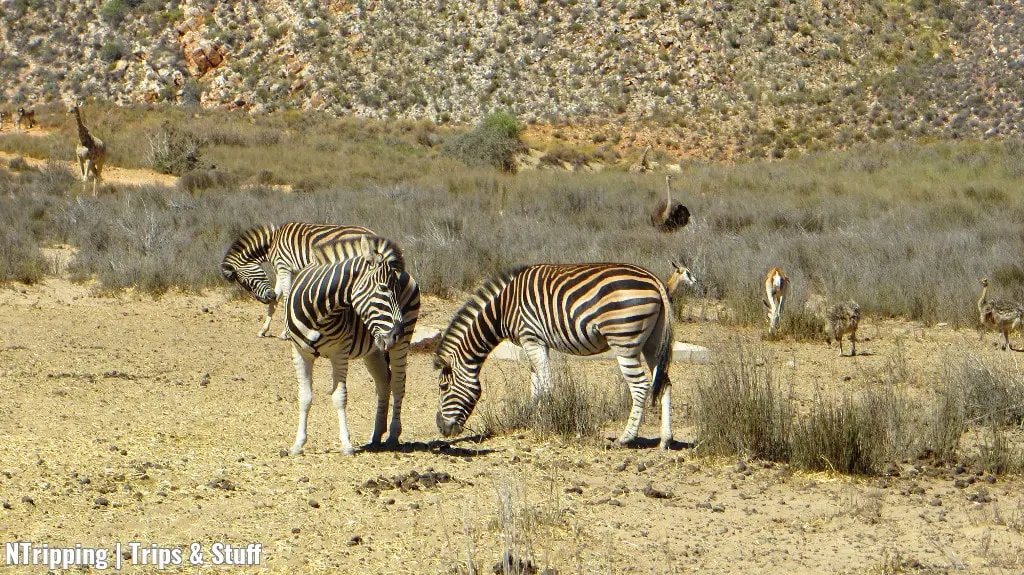
The Big 5 African Animals
Don’t forget, that even if a South African safari is advertised as a Big 5, the chances of seeing all five species (lions, elephants, leopards, water buffalos, and black rhinos) are pretty slim.
Instead of black rhinos, the reserves usually feature white rhinos. And leopards are active during the night so they are extremely rare to spot at the time the safaris normally take place.
In fact, in a private game reserve near Cape Town, which we visited in February, the manager was honest enough to tell us up front that he’s only seen a leopard in their reserve twice in his 20+ years career!
The Giant African Elephants
As you can imagine, you won’t be able to spot the Big 5 South African animals at the side of the road. But if you think Kruger Park or a private game reserve are the only places to see them, you’re wrong.
Sanctuaries rescue elephants from circuses, private zoos, or the wilderness. The animals have been mistreated or injured and could not have survived on their own. In the sanctuary, they’re not simply fed but taught to take care of themselves.
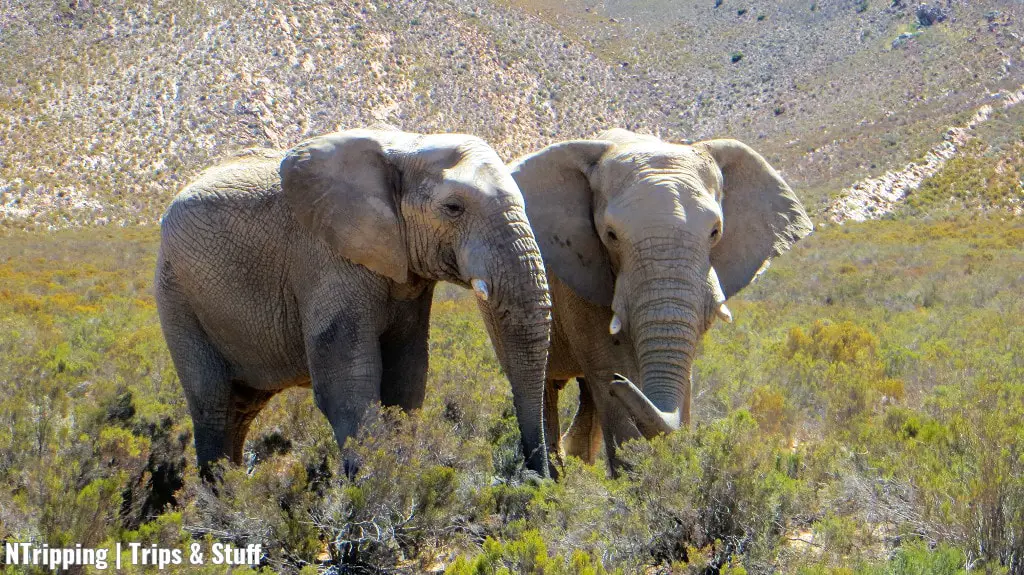
The greatest wild animal encounter I had in South Africa was with an elephant lady. She was rescued after her trunk had been injured.
African elephants use their trunks as a multifunctional tool. They breathe through it, they grab things such as food with it, and they use it as a hammer.
The elephant’s trunk was caught in a trap and it was badly injured so the end had to be amputated. She was then brought to the sanctuary where she learned through exercising to suck things instead of grabbing them and work around her disability.
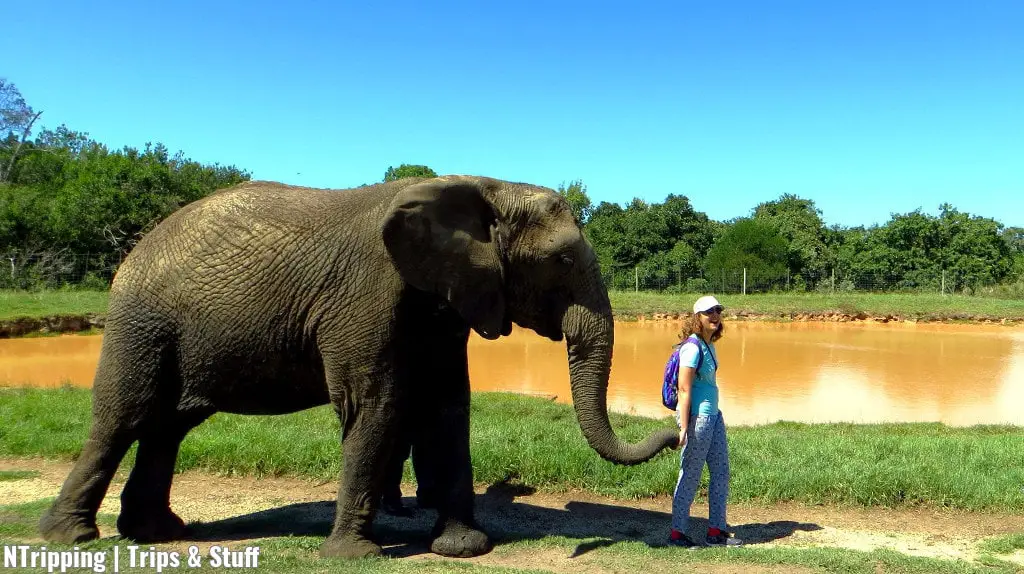
The highlight of the visit to the Elephant Sanctuary near Plettenberg Bay on the Garden Route is the walk trunk in hand with the elephant ladies.
Having the trunk gently suck or grab the palm of your hand, feeling the rough skin of the elephants touch you, and the close presence of the giant ladies is an unforgettable experience.
Time needed: approximately one hour.
Another great place for elephant encounters is Addo Elephant National Park on a self-guided safari.
The Proud African Lions And Wild Cats
Have you ever wondered why lions and big cats appear so lazy?
Lions swallow whole chunks of meat without chewing it. They eat once every 3 to 4 days and use the time between meals to digest.
That’s why lions you encounter on safaris look totally uninterested in you. Occasionally, they’ll do something more intriguing than yawning. Like crossing the road to find a better shade.
Or attempting to have intercourse with their sibling despite the fact they’ve been castrated.
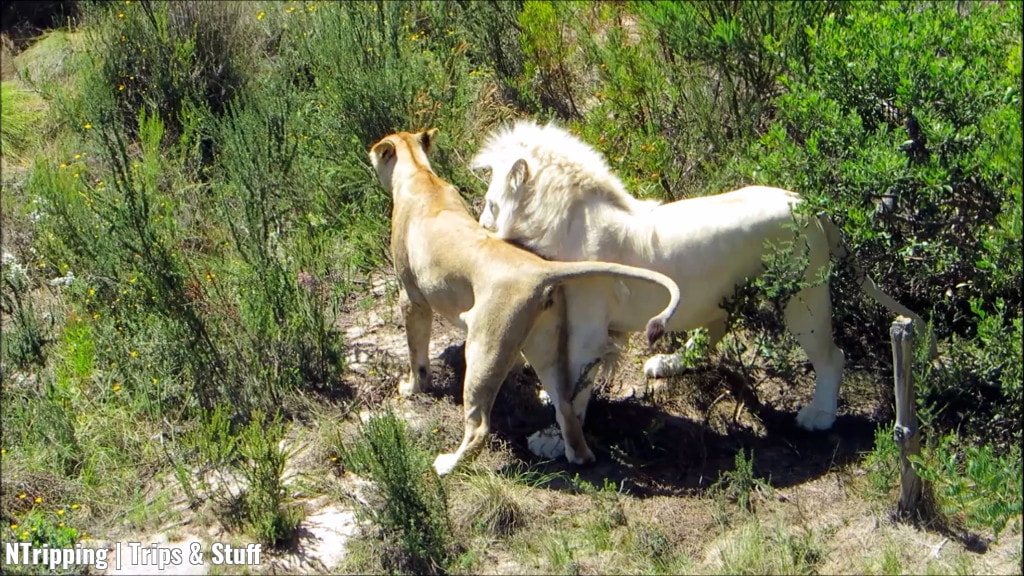
It is difficult to stumble upon most wild cats in nature, and honestly even in game reserves. If you wish to encounter these South African animals, it makes more sense to visit a wildcat sanctuary. There you can walk straight into the fenced area of almost every cat and observe them from a close proximity.
Time needed: approximately one hour.
The Only Diurnal African Animal Of The Shy 5
The Shy 5 are not as spectacular or famous as the Big 5 African animals but at least one of their members is more fascinating than you could ever imagine.
The Klein Karoo is one of the few places in South Africa where you can say “Good morning!” to the meerkats.
To see them, you have to wake up hours before sunrise. With a cup of coffee and a folding chair, you’ll be seated before the burrow where the suricates have spent the fading night.
Every evening, the guides have to search the territory to find out in which burrow the meerkats family goes to sleep. Their territory is quite large and they have dug homes at several locations.
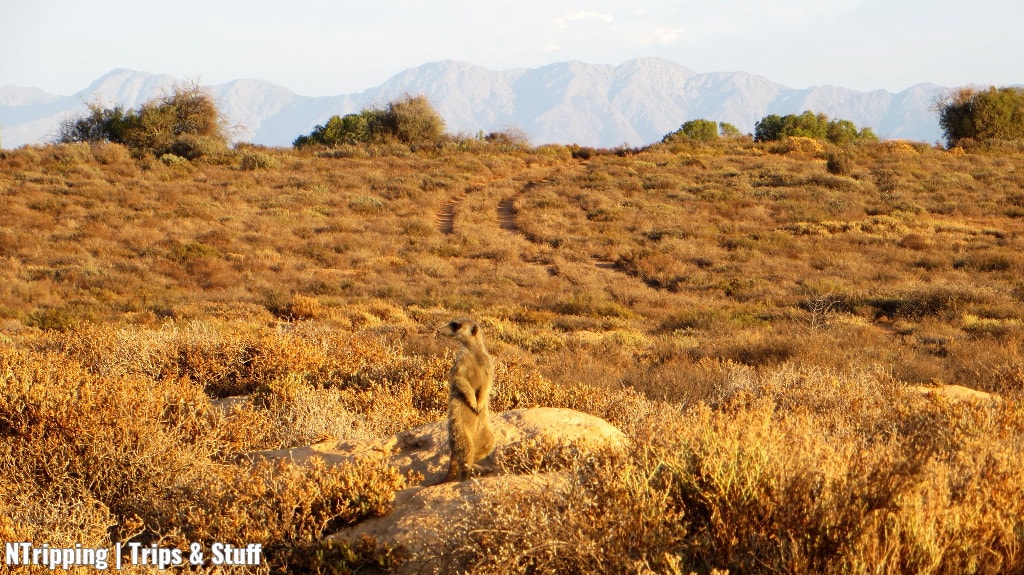
If the guides don’t know which burrow exactly the meerkats went to sleep in, they don’t know where to take the tourists the next morning to wait for these incredible South African animals to make their presence.
However, searching for the meerkats at the end of their hunting day is a challenging task. The way the guides describe it, it’s like looking for a large golden stick in the middle of the dry semi-desert. The stick they spot might or might not be the current meerkat guard.
The guides now have to stare long enough at the “stick”. If it eventually moves, then it was indeed the meerkat guard and the guides can observe and follow him and the family to the burrow where they’ll spend the night.
If the stick doesn’t move for a long time, then it was unfortunately just a stick. So the guides have to look for another long object sticking up in the air out of the Klein Karoo ground.
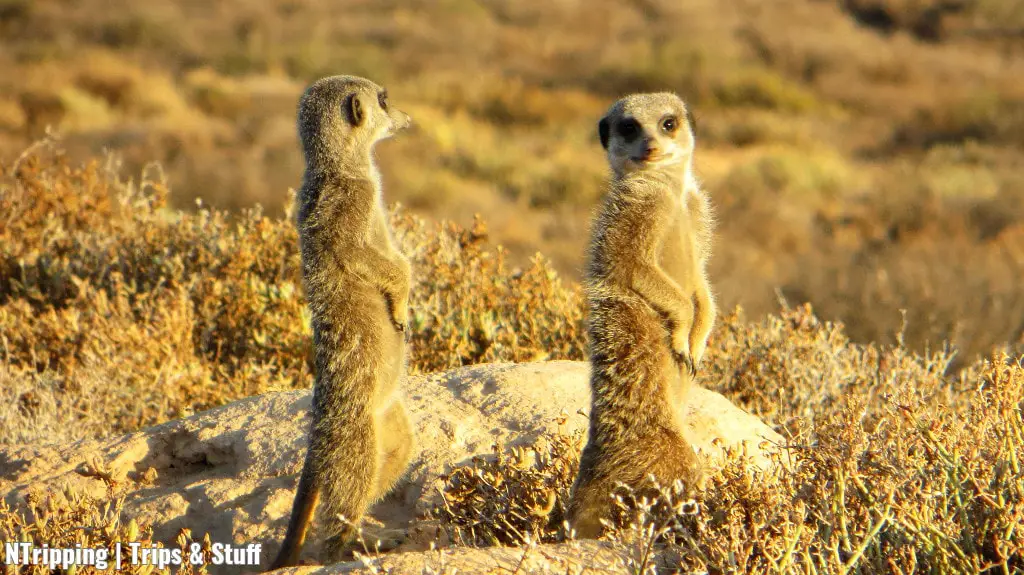
The Meerkats’ Cute Looks Hide Their Cruelty
Meerkats are known for their cruelty, even towards their own.
They live in families and recognise each other by their smell. The family lives and poops together, sleeps and rolls in their excrements, and therefore share a common scent.
When a male meerkat hits puberty, he starts developing his own scent which differs from the smell of the rest of the family members. The adults chase the teenager away and if he doesn’t get the clue, they might even kill him.
If the young male understands the situation and leaves his family, he needs to start his own. He, therefore, finds another meerkats family, stands at the border of its hunting territory and starts shouting. In this way, he draws attention to himself. Unfortunately for the other family, he also draws the attention of the predators to them.
The meerkats family chases the invader away. He starts running but only so fast so that they can neither catch him nor lose him. He draws them away from their territory and seduces one of the young females.
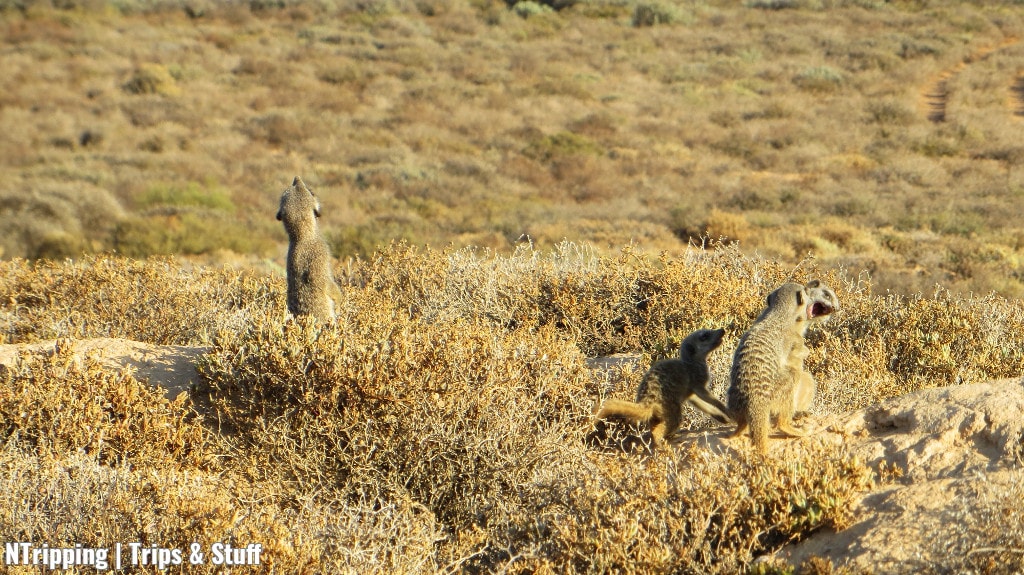
The female meerkat now has the scent of the foreigner all over her. She can’t return to her family as they won’t recognise her and will kill her as she’s now an invader for them. She has no other choice but to join the young male and start a family with him.
Time needed: between two and six hours depending on the meerkats’ mood.
The Astonishing African Flightless Birds
Somehow a bird that doesn’t fly seems more fascinating than one which does.
The flightless African birds have other great qualities despite their wings being practically useless.
The Loud African Penguins
You can observe a colony of African penguins, also called donkey penguins because of their loud calls resembling the call of the donkey, at Boulders Beach near Cape Town.
A few members of the colony venture to the nearby beaches of Simon’s Town as well so if you don’t want to pay the ticket and walk the wooden pier to the Boulders Beach, you can simply watch them there.
But then you’ll miss out on the magnificent sight of thousands of undisturbed African penguins, enjoying the gorgeous white fine-sand beach and going about their everyday life, completely ignoring the presence of the tourists.
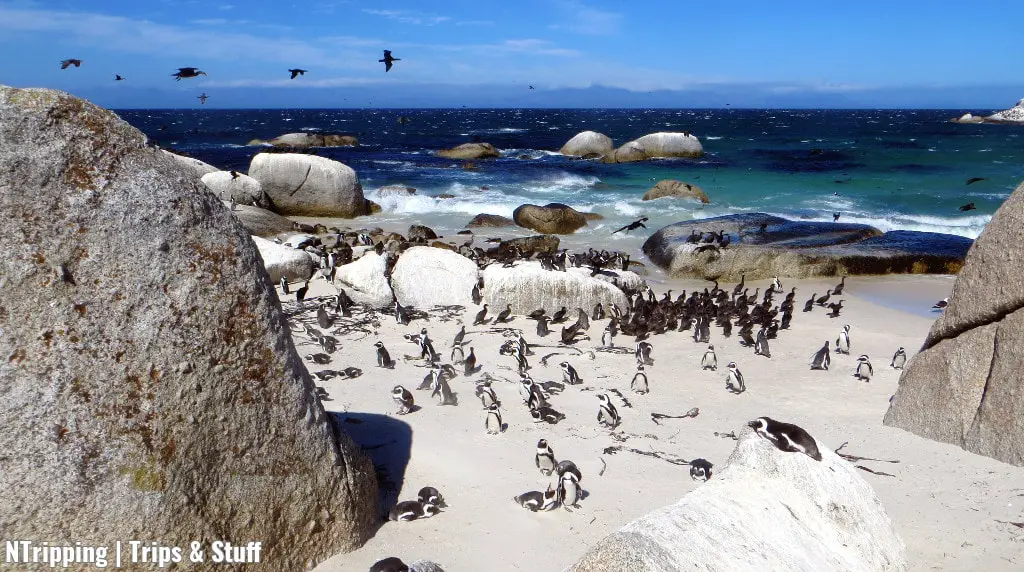
Beware that it’s quite windy on the beach. The fine sand in the air will give you a nice natural facial scrub as part of the experience.
Time needed: approximately one hour.
The Prettiest Ostriches Of The Klein Karoo
If you happen to pass through the largest town in the Klein Karoo, Oudtshoorn, make sure to visit an ostrich farm. Oudtshoorn is known as the Ostrich Capital of the World and the ostriches from the Little Karoo are believed to be the prettiest members of their species.
Since the 1860s, farmers are domesticating, breeding, and hatching ostriches’ eggs in incubators without decreasing the beauty and the quality of their feathers.
Passing through the Klein Karoo, you’ll see ostrich herds and ostrich farms everywhere. Stop for a visit and you won’t regret spending your time there.
You can cuddle with the cute little ostrich chicks, covered in weirdly prickly feathers. You can then feed the always-hungry adult ostriches.
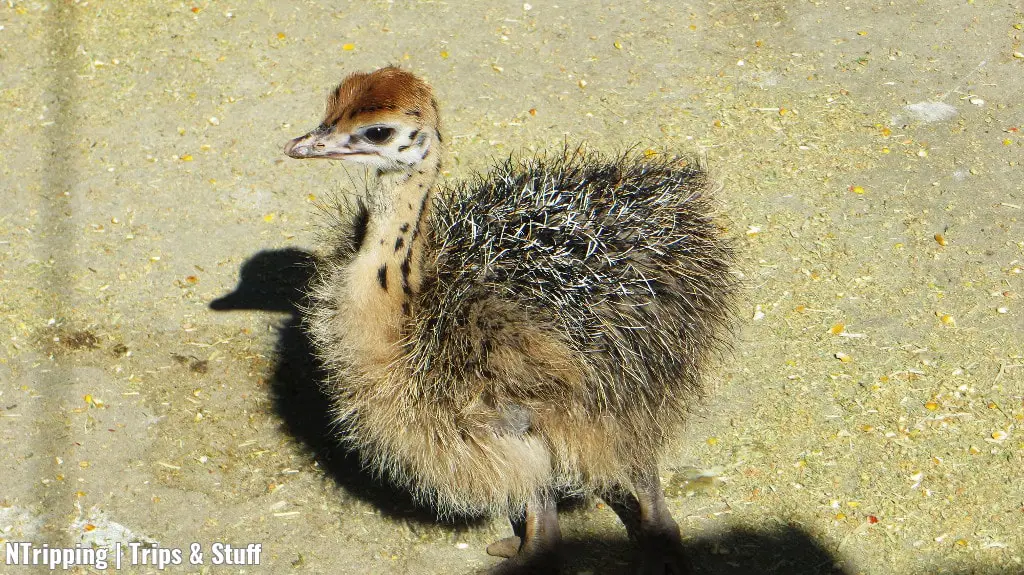
Don’t miss a chance to stand on an ostrich egg. The 2 mm (0.08 in) thick shell is extremely strong and will hold your weight.
The highlight of an ostrich farm visit, however, is riding the flightless birds. Not everyone will be brave enough to sit on the back of an ostrich, though. The next best thing is to watch the professionals race on the backs of the ostriches.
Time needed: approximately two hours.
The Freely Roaming Monkeys
Monkey Island near Plettenberg Bay is the first multi-species primate sanctuary where the inhabitants are freely roaming the woods.
During the monkey safaris, you can encounter some of the 550 different species who live there. Capuchin monkeys, ringtail lemurs, black-and-white ruffed lemurs, saki monkeys, squirrel monkeys, vervet monkeys, langurs, howler monkeys, gibbons are only a few of the inhabitants.
They roam freely and come extremely close to visitors. In fact, sometimes they come so close, that the guides will advise you to take your glasses off so that monkeys don’t grab them off your face!
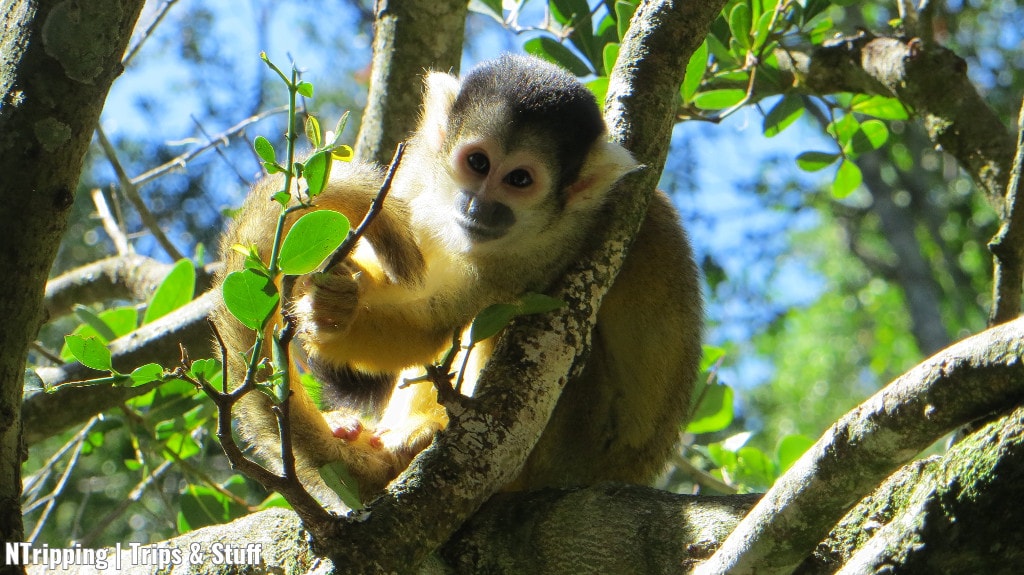
The walk through the forest trails is amazing but the best comes at the end. You’ll exit the forest via the longest canopy suspended bridge in all of Africa. The 128-metres long swings over the tree canopies giving you one last glimpse of the forest and its inhabitants.
Time needed: approximately two hours.
The Camouflaged Giraffes
Have you asked yourself what is the purpose of giraffes’ patterns?
On one hand, they’re the perfect camouflage. On the other, they’re like our fingerprints – a unique identifier for each animal.
Giraffes adapt to the environment they live in. They grow as tall as they need to be in order to feed on the vegetation in the region they were born.
Since the giraffes we observed were living in areas with low shrub and grass and they were mostly munching on bushes, they didn’t need to grow as tall as their relatives who live in the savanna and feed on trees.
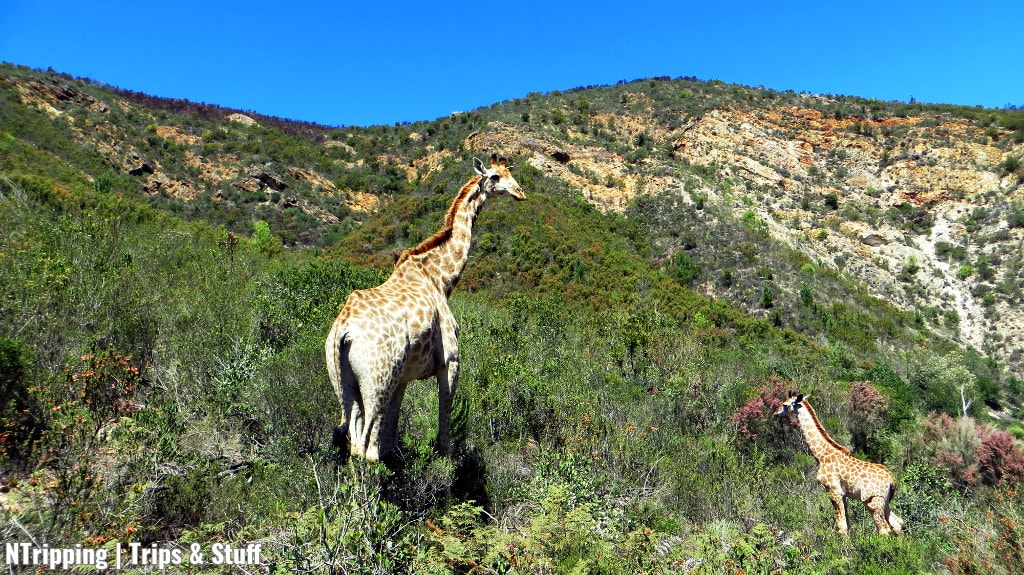
Despite the fact that these South African giraffes weren’t the tallest members of their species, they were still enormous in our eyes. Just look at the 2-months-old baby in the photo – it’s already around 3 m (10 ft.) tall!
Giraffes’ necks have the same number of vertebras as human necks – seven. So you can imagine the size of the single vertebras to result in a neck of several metres.
Many game reserves feature giraffes but the sight of a two-months-old baby giraffe is a true highlight. The little cutie we were lucky to meet and observe from just a few steps distance was born in Botlierskop Private Game Reserve near Mossel Bay.
Time needed: approximately three hours.
The Fascinating South African Animals You Can Encounter On Your Own
As you can imagine, not all of the South African wildlife can be found in enclosed quarters.
There are, indeed, multiple stunning African animals which can be seen roaming the streets or the beaches of South Africa.
The Sea Snails Munching On Jellyfishes On The Beach
An African animal I admit I hadn’t even heard of can be seen on the Indian Ocean sand beaches.
It’s strange, it moves in a weird way, and it leaves fascinating trails. It’s also a scavenger who scents decaying animals from a large distance and feeds in packs.
I’m talking about Bullia digitalis, a sea snail species.
It was hard telling at first what the tiny South African animals were doing. It looked like they were having sex on the beach – not the cocktail but the activity. Then, we realised there was food involved in the orgy.
The sea snails suck the soft tissue of the jellyfishes or blue bottles, which are washed by the tide. In an hour or so they are able to devour a huge jellyfish corpse and make it unrecognisable.
Their movements seem like a slow-motion horse gallop. They spread their foot like a sail and move at a slow pace, leaving fascinating trails on the sand.
The Baboons At The Side Of The Road
You’ll see baboons crossing a busy street and you might think to yourself that they’re suicidal. However, baboons are extremely smart and can weigh in the risks they take with incredible precision.
The truth is, if you travel around South Africa, you’ll never see a baboon’s carcass on the pavement. They might appear slow or reckless to you but they know exactly when to speed up and escape the cars.
If you stop at the side of the road, especially for a picnic or a snack break, make sure you don’t leave your car open or your food unattended. Baboons are fast and clever. They will grab your bags and disappear before you can realise what has happened.
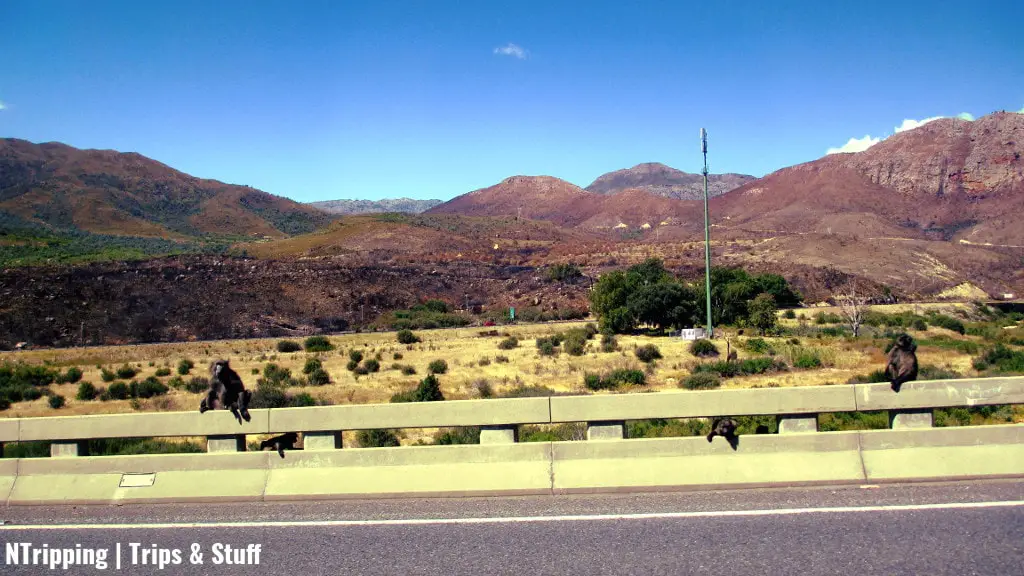
They’re also strong and can become aggressive in a blink of an eye. So better keep your distance, don’t try to feed them, and under no circumstances try to pat them unless you want to lose a finger.
The Dassies, The Mascots Of The Table Mountain
The African animal, which will catch your eye and probably even make you laugh, is the rabbit-looking dassie – the unofficial mascot of the Table Mountain.
Despite its looks, it’s actually a hoofed mammal and a relative of the elephant.
Most tourists, who are lucky enough with the weather and manage to visit the Table Top, see dassies on their visit. While we were blessed with perfect weather for a visit to the Table Mountain, we didn’t spot a single dassie.
That’s the problem with the South African wildlife – there’s no guarantee you’ll meet your rodent.
It seems that sometimes not spotting the mascot animal is actually a rarer experience than spotting one, so we’ll consider ourselves extremely lucky in this situation.
The Most Fascinating South African Animals
As you can see, stumbling upon South African wildlife isn’t only possible on a game drive.
Sometimes all you need to do is go to the beach.
Other times it’s much better to compromise on the wild park and head to a sanctuary where the chances of coming closer and experiencing the South African animals is greater.
It doesn’t need to be expensive, either. There are budget safaris in South Africa to serve every pocket.
No matter which option you prefer, don’t forget to keep your distance from the animals and treat them with the respect they deserve. You’re not in the zoo or at the circus and most accidents with safari animals or wildlife occur due to the recklessness of the tourists.
It was a tough choice narrowing down the list to only 10 among all the stunning African animal encounters during our fantastic trip to South Africa. As with any travel experience, you can’t see and do everything a destination has to offer so I hope I can enhance this list the next time I visit the vibrant South Africa.
Have you been on a safari or have you visited a sanctuary? What was the most fascinating African animal you’ve encountered?
Optimise your travels – connect better with the people you meet!
Do you know what the best way to immediately enhance your travel experience is?
Talking to the people you meet on the road!
Learn how to say “Hello!“, “Thank you!” and “Good bye!” in 36 languages.
Download the Traveller’s Free Phrasebook now.
[yikes-mailchimp form=”6″ submit=”Yes, please!”]
Once you’ve confirmed your e-mail address, you’ll receive a link to download the phrasebook. You’ll also receive updates about new stuff on this website approximately every 3 weeks. You can unsubscribe at any time. Learn more about our Privacy Policy.
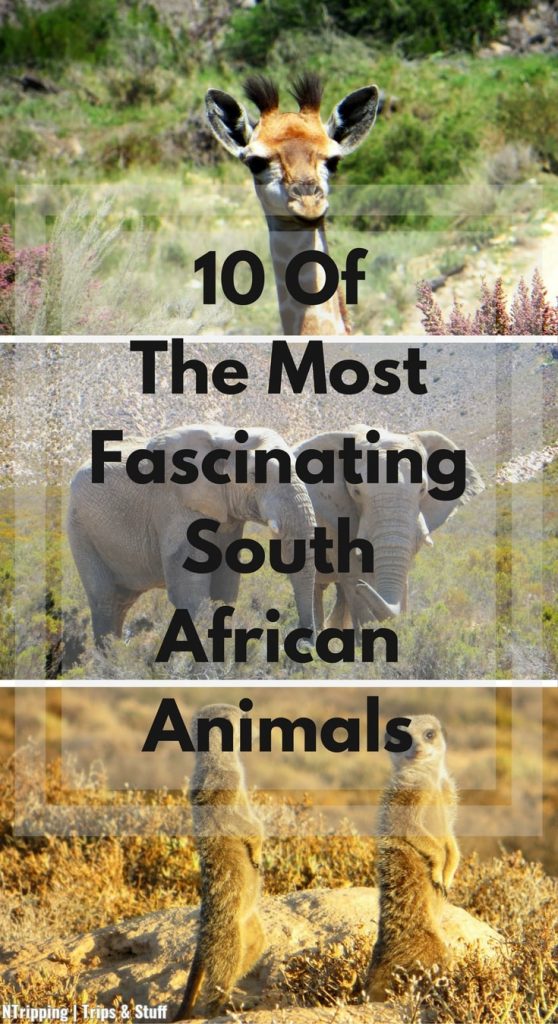

Wow, what a fauna-diversity! I really enjoyed grinning at these gorgeous creatures as some of them are quite funny :)))
I want a similar post on the Dominican Republic. It’s also diverse in terms of animal kingdom, isn’t it? :)
Hey Svet, I’m glad you enjoyed the post – it was a tough choice narrowing it down to just 10 African animals!
As for a similar post on the Dominican Republic, I must disappoint you – nothing much interesting to report. However, the most diverse fausa-wise destination in the world is Costa Rica… and I’ve visited! But it’s again tough to narrow it down and put all amazing experiences in a couple thousand words ;-) So a post about it will go live some day, I just can’t promise you when.
Cheers,
N.
Hey, N, haha, I am sure it was quite daunting a task to compile a list of just 10 animals!
Yes, you are right, Costa Rica is super diverse! Sooo, I am looking forward to receiving a notification on my e-mail with something sexy about it! <3
Svet
Looks like you and the elephant became pretty good friends! Glad the trunk is in your hand!
And love the penguins! If it were possible, I’d adopt one!
The elephant ladies are astonishing! And you’re not the only one wanting to adopt a penguin ;-) Although on second thought, I think I’d rather adopt the baby giraffe. Or a meerkat… Hm, it’s difficult to choose just one African animal, right!
Amazing collection